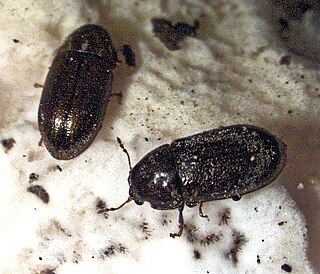
Rattus is a genus of muroid rodents, all typically called rats. However, the term rat can also be applied to rodent species outside of this genus.

The bush rat or Australian bush rat is a small Australian nocturnal animal. It is an omnivore and one of the most common indigenous species of rat on the continent, found in many heathland areas of Victoria and New South Wales.

The minute black scavenger flies or "dung midges", are a family, Scatopsidae, of nematoceran flies. Despite being distributed throughout the world, they form a small family with only around 250 described species in 27 genera, although many await description and doubtless even more await discovery. These are generally small, sometimes minute, dark flies, generally similar to black flies (Simuliidae), but usually lacking the humped thorax characteristic of that family.

The heath mouse is a species of mouse in the subfamily Murinae, the Old World rats and mice, found in Australia.

The dusky-footed woodrat is a species of nocturnal rodent in the family Cricetidae. They are commonly called "packrats" or "trade rats" and build large, domed dens that can reach several feet in height. Coyotes and other predators will attempt to prey on these rodents by laying waste to the dens, but the sheer volume of material is usually dissuasive. Occasionally, dusky-footed woodrats will build satellite dens in trees. Although these animals are solitary, except in the mating season, dens are frequently found in clusters of up to several dozen, forming rough "communities". The mating system in this species appears to be variable, with promiscuity most generally at high population densities and monogamy at lower densities.
Argyroeides is a genus of moths in the subfamily Arctiinae. The genus was erected by Arthur Gardiner Butler in 1876.

Pagara is a monotypic moth genus in the family Erebidae. Its only species, Pagara simplex, the mouse-colored lichen moth, is found in North America, where it has been recorded from Alabama, Arkansas, Florida, Georgia, Illinois, Indiana, Iowa, Kansas, Kentucky, Maryland, Mississippi, New Hampshire, North Carolina, Ohio, Oklahoma, South Carolina and Tennessee. Both the genus and species were described by Francis Walker in 1856.
Trocodima is a genus of moths in the family Erebidae. The genus was described by Watson in 1980.
Azaleodes micronipha is a moth of the family Palaephatidae. It is found in Australia from Tamborine Mountain and Lamington National Park in Queensland to Mount Keira and the Barren Grounds Fauna Reserve in New South Wales.
Azaleodes brachyceros is a moth of the family Palaephatidae. It is known only from the Upper Allyn River in New South Wales, Australia.
Azaleodes megaceros is a moth of the family Palaephatidae. It has only been found in Australia at the Dorrigo National Park and localities near Coffs Harbour in New South Wales.
Azaleodes is a genus of moths of the family Palaephatidae. The genus is endemic to Australia.
Argyroeides fuscipes is a moth of the subfamily Arctiinae. It was described by Rothschild in 1911. It is found in Brazil.
Eilema fuscipes is a moth of the subfamily Arctiinae first described by George Hampson in 1893. It is found in Sri Lanka.
Trocodima fuscipes is a moth of the family Erebidae. It was described by Augustus Radcliffe Grote in 1883. It is found in the US state of Arizona.

Myrmecia fuscipes is an Australian ant which belongs to the genus Myrmecia. This species is native to Australia. Their distribution is heavily observed in South Australia and Western Australia.
Waldegrave Islands Conservation Park is a protected area located on the following islands within the Investigator Group in South Australia: the Waldegrave Island, Little Waldegrave Island and the Watchers.
Gambier Islands Conservation Park is a protected area associated with the Gambier Islands Group which is located in the middle of the mouth of Spencer Gulf in South Australia about 71 kilometres south east of Port Lincoln. The conservation park consists of the following islands from within the group - North Island, South West Rock and Peaked Rocks. Wedge Island is not included in the conservation park. The land which now comprises the conservation park was previously declared as Fauna Reserves in March 1967 under the Fauna Conservation Act 1964 and was re-proclaimed in 1972 under the National Parks and Wildlife Act 1972. The area under protection is considered significant for the following reasons: 'a group of small islands utilised by seabirds and the Australian sea lion' and the 'North Island supports a population of the southern bush rat .' The conservation park is classified as an IUCN Category Ia protected area.

Cis fuscipes, the minute tree-fungus beetle, is a species of minute tree-fungus beetle in the family Ciidae. It is found in Australia, the Caribbean, North America, Oceania, and Europe.
This page is based on this
Wikipedia article Text is available under the
CC BY-SA 4.0 license; additional terms may apply.
Images, videos and audio are available under their respective licenses.







